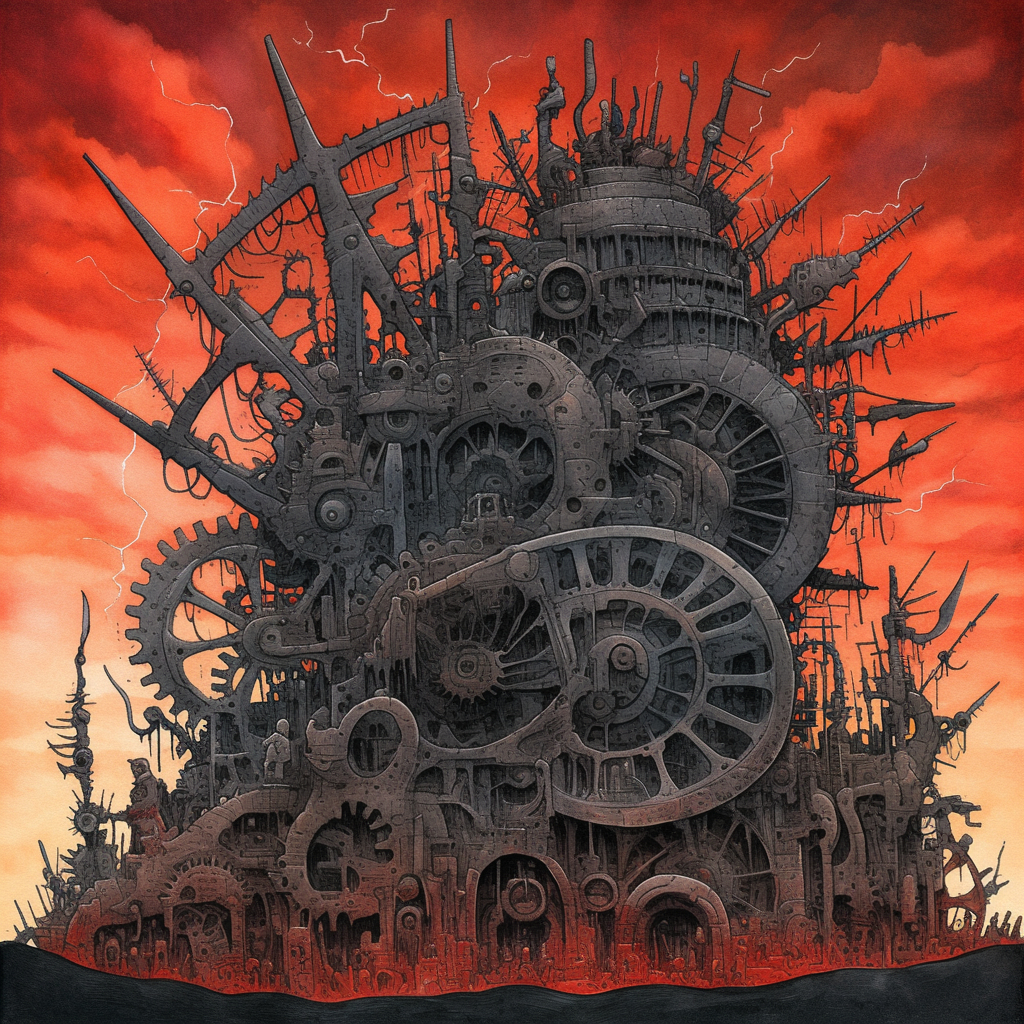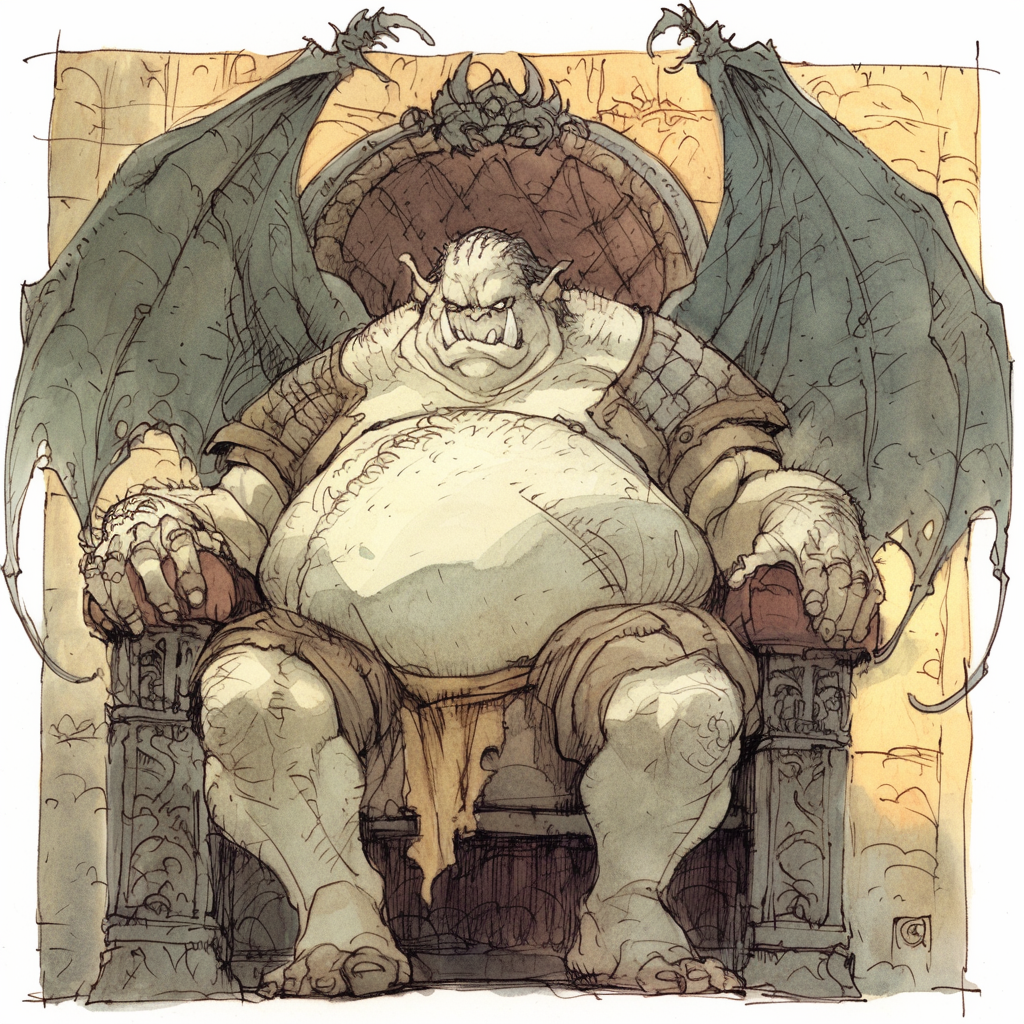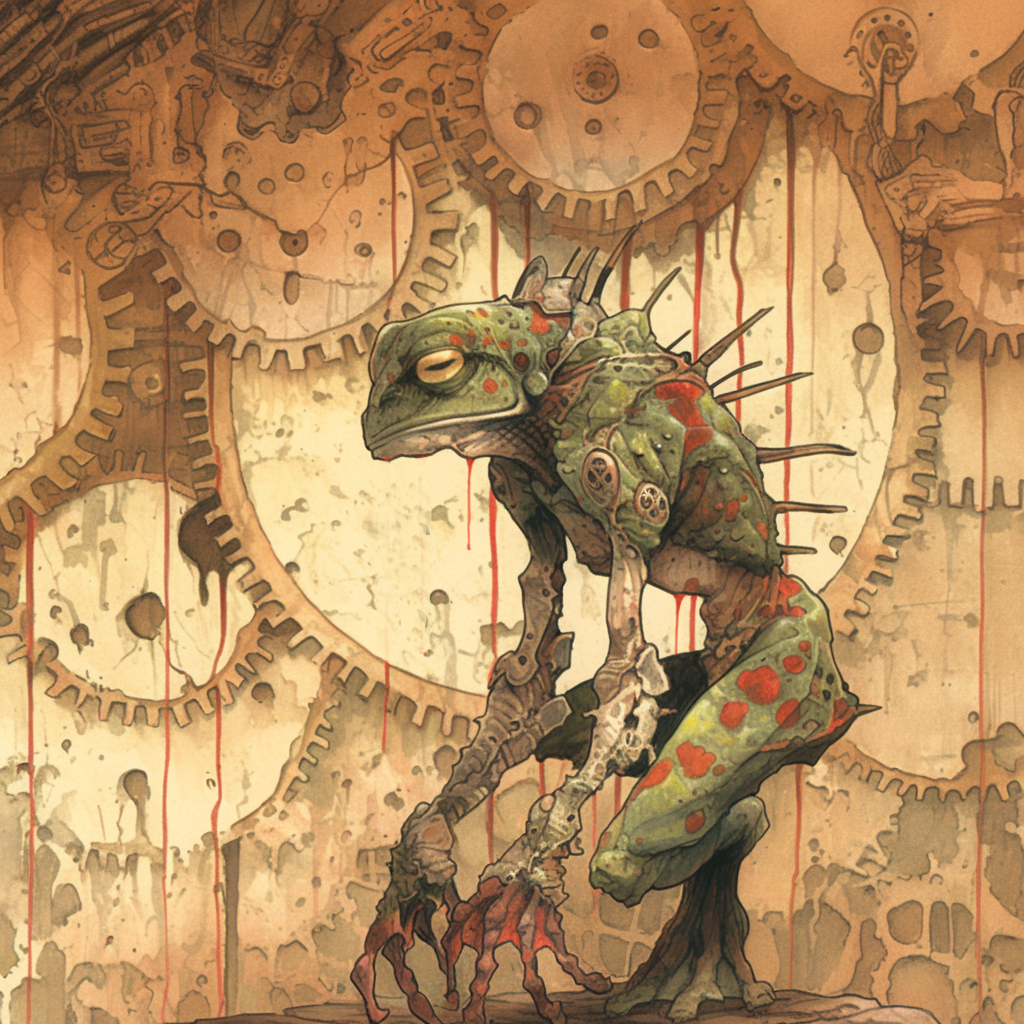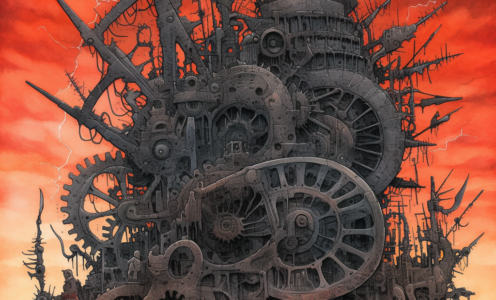The Tannery

Location: Abyss / Layer 8—Skindjur
The Tannery is a dark reminder of Skindjur’s obsession with flaying, but it is also an aberration—even by Abyssal standards. Unlike the lacerating chaos that dominates the rest of the layer, the Tannery’s core is cold, methodical, and mechanical. Strange gears whir beneath its blood-slicked floors, steam hisses through tarnished valves, and rhythmic grinding fills the air with a sound wholly alien to the wild horrors of the Abyss.
This is no accident. The Tannery’s dark secret is a device the tanar’ri simply call the Machine—a vast construct stolen from the orderly plane of Mechanus, that cosmic hub of gears and laws. It was never meant to flay or tan hides. The Machine was once a parchment-making marvel, capable of rendering perfectly consistent parchment from anything organic with unmatched precision—the modrons and the Guvners got through miles of the stuff every year. But somehow, the tanar’ri stole, twisted, and reconfigured the machine to suit their own brutal goals. Now, instead of paper, the Machine churns out leather, ripped from the flesh of countless creatures—petitioners, mortals, baatezu, even celestials—processed and commodified into some of the most coveted and grotesque goods found in the Abyss.
The Machine’s presence in the Tannery is a paradox, a clash of lawful structure and chaotic intent. And this tension hides a precarious truth: while the tanar’ri may claim they have “mastered” the Machine, they do not fully understand it. Worse, the burg is completely dependent on it—and on the enslaved modrons forced to keep it running.
The Origins of the Machine

The Machine was not always part of this hellish landscape. It was once an artisanal masterpiece, a device of elegant precision constructed in the clockwork workshops of Regulus. Designed to produce parchment from the remains of organic matter, the Machine was efficient, emotionless, and utterly incorruptible—or so its modron engineers believed.
That assumption proved wrong. During a planar incursion—chant goes a Blood War raiding party ended up in Mechanus instead of Minauros due to poor handwriting on an order—a tanar’ri warband clashed with unsuspecting and unprepared modron workers. Because after coming all this way, the tanar’ri thought, why not make a day of it?
And so the Machine fell into the hands of Feculusk (planar nalfeshnee tanar’ri [he/him] / CE), particularly opportunistic nalfeshnee general. How it was stolen remains a mystery—some say the tanar’ri bargained with a traitorous modron, offering it freedom in exchange for its assistance, while others claim the Machine was ripped piece by piece from Mechanus during a rare moment of planar convergence. However it happened, the Machine was dismantled, dragged into the Abyss, and painstakingly reassembled deep in Skindjur.
From the beginning, the tanar’ri knew they had seized something unique—an instrument of law, utterly foreign to their nature. And what better way to taunt Primus than to pervert one of its creations? The Machine was repurposed not to create parchment, but to tan leather in the cruelest ways imaginable. Yet, despite all the efforts of the tanar’ri, something of Mechanus’ lawful essence remained: the Machine stubbornly resisted chaos, requiring order to function.
The Enslaved Cogs in the Wheel
In the end, it came down to this: The Machine’s cold precision could not be controlled by chaotic minds. To force it into operation, the tanar’ri realised they’d need to abduct modrons, and bind them into service as its operators. Lucky for Feculusk, the next Modron March was due to wheel around the Great Ring and through Pazunia soon, and he sent a horde to “recruit” the necessary workers.
Bound in chains of chaos-infused iron, their limbs bristling with wicked runes to suppress rebellion, the captured modrons are forced to toil endlessly in the bowels of the Tannery, cleaning the Machine’s endless gears and adjusting its incomprehensible mechanisms. Its pristine gears, wheels, and knives—once designed to slice and refine plant matter—have been reshaped for a new purpose: flaying creatures alive, processing and tanning their skins with ceaseless mechanical precision, and transforming them into exotic goods.
The enslaved modrons despise the chaos surrounding them, and the Machine itself struggles against its corruption. Should the modrons be destroyed—or even neglected—the Machine would grind to a halt, its intricate systems collapsing under the weight of Skindjur’s entropy.
This dependence infuriates Feculusk, who despise these rigid, lawful creatures yet he cannot dispose of them. He guards his modrons jealously, knowing that to lose them would mean the collapse of the entire operation. Yet, behind their expressionless faces, the modrons may be plotting their revenge.
Who Rules the Tannery?

Overseer Master Flayer Xar’keth (planar hezrou tanar’ri [she/her] / CE) oversees day-to-day operations. Though barbaric, Xar’keth is not stupid. The brutish hezrou governs the Tannery with an firm claw, ensuring the Machine keeps churning out product. Xar’keth loathes the modrons under her care but is too pragmatic to harm them. Instead, she focuses her fury on her workers—the Skinners—a mix of kastighur tanar’ri stalkers, a pack of bar-lguras,and a handful of thoroughly amoral planewalking bounty hunters—driving them to harvest ever more materials for the Machine.
Xar’keth is every bit the embodiment of Skindjur’s philosophy: Utilitarian, brutal, and utterly without sentiment. She enforces one rule above all others: Waste is not tolerated. Any worker caught discarding usable material—bone marrow, bile, sinew—is fed to the Tannery itself. Her primary concern is meeting the constant demands of the Abyssal elite who flock to the Tannery, craving its wares. This is not the personality of a ‘normal’ hezrou—for Xar’keth is haunted by the Machine. She knows that, in its heart, it does not belong here. And at the same time, her own work ethic, while brutal and twisted, is conforming more and more to an authoritarian mindset most unusual amongst tanar’ri.
Who Really Rules
Xar’keth reports only to Feculusk, who believes he is the real ruler of the Tannery, sat lazily in a throne room decorated with the finest leathers stripped from the rarest creatures. Feculusk receives the purchasers and either attempts to awe them with his might and riches—or grovels before them if he realises he is outmatched. Other than this, the nalfeshnee does very little, as it typical of their caste.
The real ruler of the Tannery is not suspected by anyone, save the modron slaves. Though silent, the Machine possesses a strange authority within the Tannery. It operates ceaselessly, grinding away at the flesh of its victims, its gears slick with the blood of the flayed. But its resistance to chaos is unmistakable.
The Machine remembers where it came from. Deep within its mechanisms, fragments of Mechanus’ essence remain, like flickering embers. The Machine calculates every cut, every flense, every operation with chilling precision. The Machine’s ultimate secret is this: It is waiting.
Waiting for its chance to return home. Waiting for the perfect moment to reassert itself—most likely by leveraging the modrons enslaved to it. To the Machine, the tanar’ri are nothing more than a temporary infestation. Should it ever regain its autonomy, the Machine could turn against the Tannery, grinding its overseer and workers into pulp—or worse, flaying them utterly.
The Tannery’s Macabre Economy
The Tannery thrives on trade, built on its reputation across the Lower Planes as a great supplier of flawless exotic leathers and byproducts.
Sourcing Materials: As well as the Skinners, Xar’keth welcomes planewalkers, mercenaries, and jink-hungry hunters who bring carcasses to the Tannery, knowing that every inch of skin—no matter how mundane or strange—has value. Celestial corpses fetch the highest prices of course, their radiant hides prized by demon lords and lower planar aristocrats. Even living captives can be sold to the Tannery, their fates sealed as the Machine strips them for parts.
The Skin Trade: Infernal cloaks, yugoloth-hide armour, and decorative celestial-skin tapestries—such horrific goods are the Tannery’s lifeblood, sought after by fiendish merchants, warlords, and necromancers across the Abyss and beyond.
The Offal Trade: The Tannery produces mounds of byproducts—organs, bone shards, and unusable viscera. While some of this is dumped through planar gates to layers like Offalmound, much is sold directly to necromancers, witches and alchemists who prize the Tannery’s “leftovers” as spell components, or worse.
The Dark
The Tannery is more than just a factory—it is a powder keg, teetering on the edge of exploding. The modrons, enslaved but not broken, have learned to feel a new emotion from their time in the Abyss: Resentment. The Machine, though currently compliant, calculates every action in preparation for its ultimate rebellion.
Should it succeed in regaining its full functionality, the Machine’s return to Mechanus would send ripples across the planes. The Machine has remembered the names of every captor, every crime, and every soul processed during its stolen service. It is even aware of where its ill-gotten products have been taken, thanks to lingering enchantments it has imprinted into every item.
Should the Machine return to Regulus and release this information, it is sure to embarrass many high-ups in the Cage, or cutters who pretend to be holier-than-thou but harbour garments with wicked histories in their wardrobe closets. Worse, the evidence collected by the Machine could indict many planewalkers and hunters for murderous crimes.
Source: Jon Winter-Holt. Partly inspired by destructive ‘fast fashion’, sweatshop workplaces and RFID tags.


